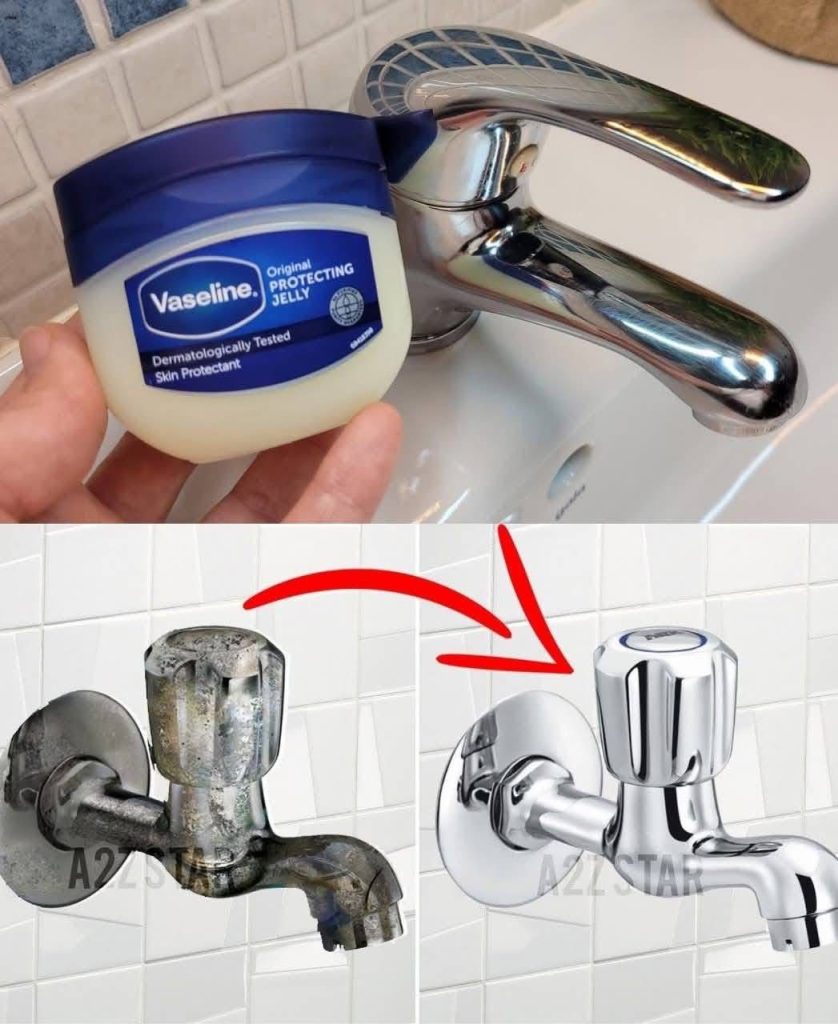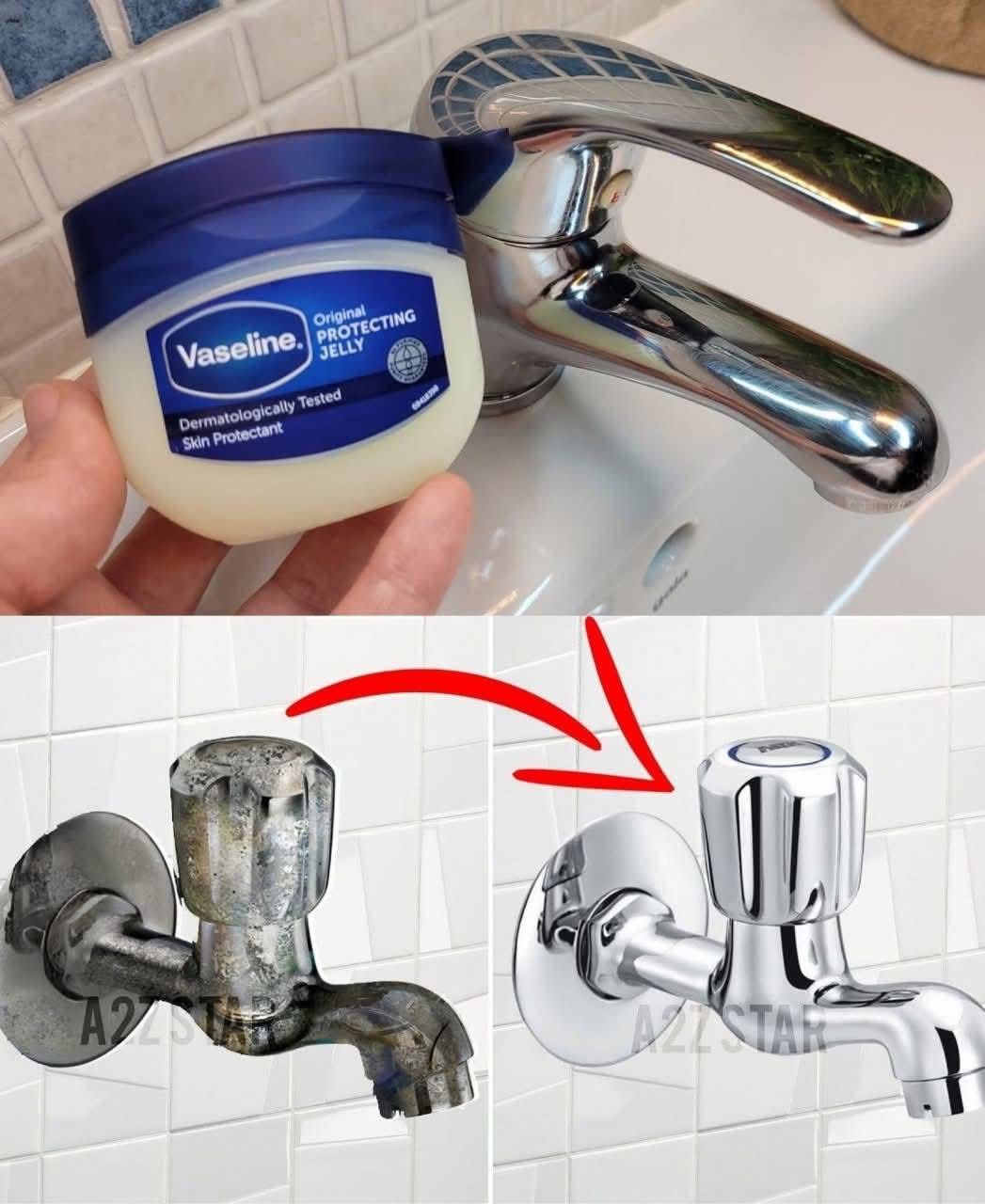The Surprising Power of Vaseline for Cleaning and Restoring Metal Fixtures

Introduction
Vaseline, or petroleum jelly, is widely known for its skincare benefits, but did you know it can also be a powerful tool for household maintenance? Whether you’re dealing with dull, corroded, or rusted metal fixtures, Vaseline can help restore their shine and protect them from further damage.
Metal surfaces in our homes, such as faucets, door handles, and pipes, are prone to oxidation, limescale buildup, and dirt accumulation over time. Instead of relying on expensive chemical cleaners, Vaseline offers a simple, cost-effective solution. In this article, we’ll explore how Vaseline works for metal cleaning, different application methods, and its impact on sustainability.
Methods of Using Vaseline for Metal Cleaning and Restoration
1. Restoring Shine on Chrome Fixtures
Over time, chrome fixtures like faucets and showerheads can become dull due to water stains, soap scum, and oxidation. Vaseline helps restore their original shine.
How to use:
- Clean the fixture with a damp cloth to remove loose dirt.
- Apply a small amount of Vaseline to a microfiber cloth.
- Rub the Vaseline onto the metal surface in circular motions.
- Let it sit for about 10–15 minutes.
- Buff the surface with a dry, clean cloth until it shines.
2. Preventing Rust on Metal Surfaces
Rust forms when metal is exposed to moisture and oxygen. Vaseline creates a protective barrier to prevent oxidation.
How to use:
- Wipe the metal surface dry.
- Apply a thin layer of Vaseline using a cotton cloth.
- Spread it evenly over areas prone to rust.
- Repeat this process every few weeks for long-term protection.
3. Cleaning and Lubricating Hinges and Locks
Door hinges and locks can become stiff or produce squeaky sounds. Vaseline acts as a lubricant, preventing wear and tear.
How to use:
- Clean the hinges or lock mechanism with a dry cloth.
- Apply Vaseline using a cotton swab or your fingers.
- Work the Vaseline into the crevices to ensure proper lubrication.
- Open and close the door several times to distribute the jelly evenly.
4. Removing Water Stains and Fingerprints
Bathroom and kitchen faucets often show water stains and fingerprints. Vaseline can help maintain a spotless look.
How to use:
- Dab a small amount of Vaseline onto a clean cloth.
- Wipe down the affected areas.
- Use another clean, dry cloth to buff the surface.
5. Protecting Outdoor Metal Fixtures
Outdoor metal fixtures, such as garden faucets and metal furniture, are exposed to harsh weather. Vaseline acts as a waterproofing agent.
How to use:
- Clean the outdoor fixture thoroughly.
- Apply Vaseline generously to exposed metal parts.
- Reapply every few weeks for ongoing protection.
The Hidden Power of Vaseline: How to Restore and Protect Metal Fixtures
Introduction
Metal fixtures in our homes, such as faucets, handles, and pipes, tend to lose their shine due to oxidation, water stains, rust, and dirt buildup. Many people spend money on expensive chemical cleaners when a simple household product—Vaseline (petroleum jelly)—can work wonders.
Vaseline is not just a skincare essential; it’s also a powerful tool for restoring metal surfaces, preventing rust, and keeping fixtures looking brand new. This article explores the history of Vaseline, its best uses for cleaning, and how it became a household staple.
The History of Vaseline
Vaseline, originally known as petroleum jelly, has an interesting history dating back to the 19th century.
Invention of Vaseline
In 1859, a young chemist named Robert Chesebrough discovered a waxy substance accumulating on oil rigs in Pennsylvania. Oil workers called it “rod wax” and used it to heal cuts and burns. Intrigued by its properties, Chesebrough took samples back to his lab and refined the substance into a smooth, translucent jelly.
Rise in Popularity
By 1872, Chesebrough patented his new product under the name Vaseline, derived from the German word “Wasser” (water) and the Greek word “Elaion” (oil). He began selling Vaseline as a multipurpose ointment, and soon, it became a household staple for treating skin wounds, burns, and dryness.
Expansion into Cleaning & Protection
While Vaseline was first marketed for medical and cosmetic use, people soon discovered its effectiveness for rust prevention, lubrication, and metal restoration. Soldiers in World War I and II used Vaseline to protect their weapons and tools from rusting. Over time, homeowners began applying Vaseline to metal fixtures, door hinges, and outdoor furniture to maintain shine and prevent damage.
How Vaseline Works on Metal Fixtures
Vaseline is a petroleum-based jelly with hydrophobic (water-repelling) properties. When applied to metal, it creates a protective barrier that prevents oxidation, rust formation, and moisture buildup. It also acts as a mild polish, restoring shine and making surfaces look as good as new.
Benefits of Using Vaseline for Metal Maintenance
Restores Shine – Removes water stains, fingerprints, and oxidation buildup.
Prevents Rust – Creates a protective layer against moisture and corrosion.
Lubricates Moving Parts – Ideal for door hinges, locks, and faucets.
Waterproofs Outdoor Fixtures – Protects against rain and humidity.
Cost-Effective and Chemical-Free – A natural, budget-friendly alternative to harsh cleaners.
Methods for Using Vaseline on Metal Fixtures
1. Restoring Shine to Chrome Faucets & Fixtures
Faucets and metal handles often lose their shine due to water stains and oxidation. Vaseline helps polish and maintain a glossy look.
How to Apply:
- Wipe the metal surface with a damp cloth to remove dust and dirt.
- Apply a small amount of Vaseline to a microfiber cloth.
- Rub in circular motions over the surface.
- Let it sit for 10 minutes.
- Buff with a dry cloth until it shines.
2. Preventing Rust on Metal Surfaces
Rust forms when metal reacts with moisture and oxygen. Vaseline forms a protective coating to stop this process.
How to Apply:
- Clean and dry the metal surface completely.
- Apply a thin layer of Vaseline using a cloth or fingers.
- Spread it evenly over rust-prone areas.
- Reapply every few weeks for lasting protection.
3. Lubricating Door Hinges & Locks
If you have squeaky door hinges or stiff locks, Vaseline acts as an effective lubricant.
How to Apply:
- Clean the hinge or lock mechanism.
- Use a cotton swab to apply Vaseline into the moving parts.
- Open and close the door or lock several times to distribute the jelly evenly.
4. Removing Water Stains & Fingerprints from Metal
Metal surfaces like bathroom and kitchen faucets can quickly accumulate water spots and fingerprints.
How to Apply:
- Dab a small amount of Vaseline onto a clean cloth.
- Wipe down the affected area.
- Buff with another dry cloth to restore the shine.
Sustainability and Environmental Impact
Unlike chemical metal cleaners that release harmful toxins, Vaseline is a safer and eco-friendly alternative. By using Vaseline for maintenance, homeowners can reduce waste by prolonging the lifespan of their metal fixtures instead of replacing them.
Additionally, Vaseline reduces reliance on single-use cleaning wipes and aerosol sprays, making it a sustainable choice for long-term household care.
From its invention in 1859 to its modern-day uses, Vaseline has proven to be a versatile household essential. Whether you’re restoring chrome fixtures, preventing rust, or lubricating hinges, Vaseline offers a simple yet powerful solution for metal maintenance.
Instead of spending money on expensive cleaning products, try Vaseline for a budget-friendly, chemical-free way to keep your metal fixtures looking brand new
How Vaseline Works for Metal Protection
Vaseline is a hydrophobic substance, meaning it repels water. This property makes it highly effective in preventing rust, corrosion, and oxidation on metal surfaces. When applied to metal, Vaseline forms a thin, protective layer that blocks moisture and air, which are the main culprits behind rusting and tarnishing.
Additionally, Vaseline has mild abrasive properties that help remove dirt and limescale deposits without damaging the metal surface.
The Science Behind Vaseline’s Effectiveness
Vaseline is composed of hydrocarbons, which create a non-reactive, oily layer on surfaces. This molecular structure allows it to act as a barrier against:
- Oxygen exposure (which leads to oxidation)
- Moisture retention (which promotes rust)
- Dirt and grime buildup (which dulls metal surfaces)
Unlike water-based cleaners, Vaseline does not evaporate quickly, making it a long-lasting solution.
Sustainability and Environmental Impact
Many commercial metal cleaners contain harsh chemicals that can harm the environment. Petroleum jelly, on the other hand, is a less abrasive alternative that does not release toxic fumes or chemical residues.
Additionally, using Vaseline reduces the need for single-use cleaning wipes, aerosol sprays, and chemical polishes, making it a more sustainable option.
Social Impact: How Vaseline Cleaning Saves Money and Reduces Waste
With rising costs in household maintenance products, Vaseline offers a budget-friendly alternative for keeping metal fixtures clean and well-maintained. Many households already have a jar of Vaseline, making it a convenient and accessible solution.
By using Vaseline to protect metal fixtures, homeowners can extend the lifespan of their hardware, reducing the need for replacements and contributing to waste reduction.
Conclusion
Vaseline is more than just a skincare product—it’s a versatile tool for home maintenance. Whether you’re looking to restore shine, prevent rust, or protect outdoor fixtures, this simple household item can make a significant difference.
Instead of spending money on expensive metal cleaners and rust removers, try Vaseline for a budget-friendly, eco-friendly solution. A little goes a long way in keeping your metal fixtures looking brand new!
